Fleas can bite, mate, and lay hundreds of eggs on your dog in just 24 to 48 hours. Your home silently harbours over 90% of a flea infestation as eggs, larvae, and pupae that hide in carpets and furniture.
Modern dog flea treatments offer powerful solutions today. Topical applications and oral medications eliminate over 99% of fleas within eight hours. These persistent parasites pose serious health risks to our furry friends, especially when you have puppies who easily develop flea-related complications like anaemia and skin infections.
A flea infestation can be stressful for pet owners. We created this detailed guide to help you eliminate fleas on your dog and stop future infestations. Let’s discover the best ways to shield your pet from these troublesome parasites.
Table of Contents
ToggleUnderstanding Dog Fleas and Their Life Cycle
You need to understand what you’re dealing with before treating a flea problem. Dog fleas are small, wingless insects that feed on your pet’s blood. These pests can make your dog miserable and cause health problems if left untreated.
How to identify fleas on your dog
Early detection of fleas helps prevent a small problem from turning into a major infestation. Adult fleas are tiny – just about 1/8″ (2.5 mm) long. These parasites look brownish-black to black, but they might appear reddish-black after feeding on blood.
Your dog might have fleas if you notice these signs:
- Excessive scratching, biting, or licking, especially around the tail, groyne, or back end
- Visible fleas or flea dirt (small black specks that look like pepper) on their fur
- Hair loss, red irritated skin, or scabbing from scratching
- Small red bumps on their skin
- Restlessness or increased sensitivity to being touched
A fine-toothed flea comb helps you check for fleas. Part your dog’s fur and pay special attention to the base of the tail and back—fleas love these spots. Black specks on the comb could be flea dirt, which is digested blood. Place these specks on a damp paper towel to confirm—they’ll turn reddish-brown if it’s flea dirt.
Why fleas are dangerous for dogs
Fleas create serious health risks beyond making your dog uncomfortable. Many dogs develop flea allergy dermatitis (FAD), which is a severe allergic reaction to proteins in flea saliva. Even a single flea bite can trigger intense itching and irritation.
Heavy flea infestations lead to flea-bite anaemia, which hits puppies and elderly dogs hardest. A single flea bites your dog hundreds of times daily, and large numbers of fleas can cause dangerous blood loss.
These parasites also spread tapeworms. Dogs can get infected if they swallow a flea while grooming. Tapeworms attach to your dog’s intestines and steal nutrients, which can cause weight loss and nutritional problems.
Fleas spread other diseases too, including Bartonella infection (cat scratch fever), murine typhus, and in rare cases, bubonic plague.
The four stages of the flea life cycle
Adult fleas on your dog make up only 5% of the total flea population. The other 95% exists as eggs, larvae, and pupae hiding in your home. You need to know about the flea life cycle to treat the problem effectively.
The flea life cycle has four distinct stages:
Stage 1: Eggs – Female fleas start laying eggs within 48 hours of their first blood meal. They produce 20-50 eggs daily, and one female can lay over 100 eggs in her lifetime. These tiny white oval eggs (about 0.5mm) fall off your dog and scatter throughout your home.
Stage 2: Larvae – Eggs hatch into larvae within 1-10 days. These white, legless, worm-like creatures (3-5mm long) hide from light in carpets, bedding, and floorboard cracks. They eat organic debris and adult flea faeces for 5-15 days before moving to the next stage.
Stage 3: Pupae – Larvae create silk cocoons and become pupae. This stage proves most resilient—pupae stay viable for several months and resist most insecticides. They become adults only when they detect a potential host through warmth, vibrations, or carbon dioxide.
Stage 4: Adults – New adult fleas immediately look for a host and start feeding. They mate and lay eggs within 24-48 hours after their first blood meal, starting the cycle again.
This cycle typically takes 3-8 weeks in normal household conditions. It might finish in 12-14 days or stretch to several months depending on temperature and humidity.
Immediate Steps to Treat Fleas on Dogs
You need to act quickly once you spot fleas on your dog. Let me show you the best ways to deal with these parasites right away at home.
Using a flea comb to remove adult fleas
A fine-toothed metal flea comb serves as your first defence against an active infestation. These specialised combs have teeth placed close together that trap adult fleas and their droppings (flea dirt) as you brush through your dog’s coat.
Here’s how to use a flea comb properly:
- Keep a bowl of warm water with a drop of washing-up liquid nearby to drown captured fleas
- Brush your dog’s dry and groomed fur
- Start from head to tail with long, gentle strokes in a systematic way
- Keep the comb against the skin to get the best results
- Focus on spots where fleas gather: behind the ears, armpits, groyne, neck, and base of the tail
Check the comb after every few strokes and dunk any fleas into the soapy water so they can’t escape. You should comb your dog outside or in an empty bathtub to stop fleas from hiding in your home.
Combing alone won’t solve the problem since it only catches adult fleas. It’s great for puppies too young for flea medicine or to check if your treatment plan works. Your best bet is to comb your dog every day during an active infestation.
Bathing your dog with flea shampoo
A medicated flea bath brings quick relief and cuts down the number of adult fleas on your dog. In spite of that, flea shampoos only kill adult fleas present during the bath and don’t protect your dog long-term.
A proper flea bath involves:
- Using flea-specific shampoo and following the label instructions exactly
- Protecting your dog’s eyes with mineral oil or lubricant before the bath
- Getting your dog’s coat wet with lukewarm water (avoid hot water)
- Working up a good lather with the shampoo
- Focusing on flea hotspots like the neck and tail base
- Letting the shampoo sit for the recommended time
- Rinsing until all shampoo is gone
Dry your dog completely with towels afterward. You’ll need to apply prescription-strength flea medicine for lasting protection since shampoos only help temporarily.
When to seek veterinary help
Most flea problems can be handled at home, but some cases need expert care. Call your vet right away if:
- Your dog seems tired or loses weight unexpectedly
- The gums look pale, which might mean anaemia from blood loss
- Your dog scratches too much even after treatment
- You see tapeworm segments that look like rice grains in your dog’s stool
- Your dog’s skin looks red, irritated, or has a bad rash
- Your dog is very young, old, or has health issues
Your vet should also look at cases where store-bought treatments aren’t working or if you’re not sure which products are safe for your dog. They can prescribe stronger flea medications and create a treatment plan that fits your dog’s needs.
Note that treating your dog is just one piece of the puzzle. Getting rid of fleas means dealing with them in your home too – we’ll get into that later in this piece.
Effective Flea Treatment Options for Dogs
Getting rid of fleas takes more than just quick fixes. Let’s look at the best long-term treatment options to keep your dog flea-free.
Prescription flea medications
Flea treatments prescribed by vets are the most reliable way to protect your dog. These medications go through extensive testing to ensure they are safe and work well. They also protect your pet from other parasites, not just fleas.
Popular prescription medications include:
- Bravecto: You can get this as chewable tablets or spot-on treatments. It protects your dog for up to 12 weeks and kills 99% of fleas within 8-12 hours. The active ingredient, fluralaner, targets the flea’s nervous system and kills them.
- NexGard: These beef-flavoured chewable tablets contain afoxolaner that kills fleas within 24 hours and works for 30 days. Research shows 89% of dogs eat these chews without any fuss.
- Simparica: Dogs who love outdoor activities benefit from these liver-flavoured chewable tablets that work against both fleas and ticks.
Over-the-counter flea treatments
Non-prescription options are easier to get but don’t all work the same way. These products come in two types:
- Regulated OTC treatments: You’ll find these in locked cabinets at pharmacies or pet shops. You need to provide basic information about your pet before buying.
- Off-the-shelf products: These are available in supermarkets and corner shops with no restrictions, but they don’t work as well as prescription options.
Popular OTC options include Frontline Plus (with fipronil and methoprene) and Seresto collars that protect your dog for up to eight months.
Spot-on treatments vs oral medications
Spot-on treatments:
- Go directly on the skin between shoulder blades
- Spread through your dog’s oil glands
- Work best for dogs with sensitive stomachs
- Don’t work well for dogs who swim often
- Need separation from children and pets until dry
Oral medications:
- Come as chewable tablets or pills
- Kill fleas when they bite your dog
- Work even with swimming or bathing
- Work well in homes with multiple pets
- Some dogs might not take them
How to apply topical flea treatments safely
Here’s how to apply spot-on treatments the right way:
- Check the product instructions first
- Keep your dog comfortable – either sitting or standing
- Separate the fur at the neck to see the skin
- Put the liquid on the skin, not the fur
- Larger dogs need treatment in several spots along their spine
- No swimming or baths 48 hours before and after treatment
- Clean your hands after application
Your dog needs regular treatment to stay protected. Most spot-on products need monthly application.
Eliminating Fleas from Your Home Environment
Getting rid of fleas completely means you need to tackle your home environment. Adult fleas on your dog make up just 5% of all fleas – the other 95% are eggs, larvae, and pupae hiding in your home. Your home will get infested again if you don’t control these environmental factors.
Washing bedding and soft furnishings
Hot water washing (at least 60°C) will kill fleas effectively at all life stages. You should wash:
- Your dog’s bedding and blankets
- Human bedding where your dog sleeps
- Removable sofa cushion covers
- Rugs and washable mats
Wash these items weekly while fighting an active infestation. Heat and detergent work together to kill fleas at every stage of their life cycle. The dryer should run on high heat for at least 30 minutes after washing to make sure all fleas are gone.
Vacuuming strategies for flea removal
A good vacuum job can kill up to 96% of adult fleas and all pupae and larvae. Here’s how to get the best results:
- Vacuum carpets, rugs, and upholstered furniture daily during an infestation
- Target cracks, corners, and areas under furniture where eggs and larvae hide
- Use a vacuum with a beater bar on carpets to shake loose deeply embedded fleas
- Lower the vacuum head completely to reach deep into carpet fibres
Vacuum vibrations encourage adult fleas to come out of their protective cocoons, which makes them easier to kill. Empty your vacuum into a sealed plastic bag right away and take it outside to stop fleas from escaping back into your home.
Using environmental flea treatments
Environmental flea treatments can protect your home longer than cleaning alone. These treatments come in two types:
Household sprays with insecticides kill adult fleas instantly and stop eggs from developing. You should vacuum all surfaces and clear away clutter before spraying. Some sprays stay active for up to 12 months and create a barrier against new infestations.
Natural options like diatomaceous earth or boric acid can work well too. These substances dehydrate fleas and interrupt their life cycle. Serious infestations might need professional pest control services that use stronger treatments with insect growth regulators (IGRs) to stop fleas from completing their life cycle.
Preventing Future Flea Infestations on Dogs
Preventing fleas is nowhere near as difficult as treating a 6-month old infestation. After you get rid of fleas, you need a detailed strategy to stop them from coming back.
Year-round flea prevention strategies
Consistency makes all the difference in keeping fleas away. Vets strongly recommend flea prevention throughout the year—not just in warm weather. This method is backed by medical research and makes more sense than seasonal treatments.
Fleas thrive inside heated homes even during cold months. Then, a non-stop prevention plan protects your dog and home.
Your vet can help you pick the right preventative product that fits your dog’s needs. You can choose from monthly spot-on treatments, oral medications, or flea collars. Note that only 5% of fleas live on your pet—the other 95% exist as eggs, larvae, and pupae in your surroundings.
Creating a flea-resistant garden
Your garden helps defend against fleas. Block any gaps in fences to keep out wildlife that often carries fleas. Keep your lawn mowed and ensure proper drainage to reduce wet spots where fleas love to breed.
Plant natural flea deterrents like rosemary, wormwood, or mint near your home’s entrances. Cedar chips or diatomaceous earth scattered in garden areas add protection without hurting plants or pets.
Regular grooming and inspection routines
Weekly grooming sessions keep your dog looking great and let you spot early signs of fleas. During these sessions:
- Use the right brush for your dog’s coat type and focus on areas behind the ears and near the tail base
- Give your dog a bath with pet-friendly shampoo every two weeks in high-risk seasons
- Clean bedding weekly at temperatures of at least 60°C to kill fleas and eggs
- Look out for redness, irritation, or too much scratching
A mix of these preventive steps and regular vet-approved flea treatments gives you reliable protection against future infestations.
Our Final Say!
Getting rid of fleas just needs proper understanding and consistent action. These persistent parasites create most important health risks for dogs. You can find effective solutions through proper medication, environmental control, and preventive measures.
Your success in controlling fleas depends on treating both your dog and home environment. Your pet’s visible adult fleas make up only 5% of the total infestation, and detailed treatment becomes essential for lasting results.
Prevention works better than cure in the battle against fleas. Your furry friend stays protected from these troublesome parasites when you maintain regular grooming, use year-round preventive medications, and keep the environment clean. Watch carefully, follow your veterinarian’s advice, and your dog will live happily without fleas.






